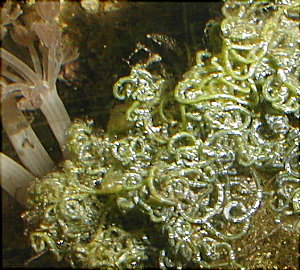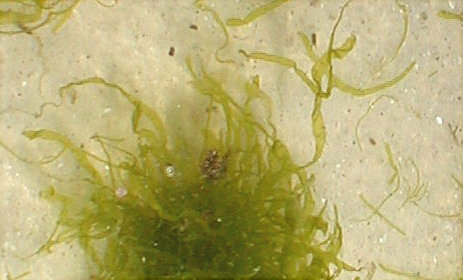The water quality of Delaware’s Inland Bays is very important to outdoor recreational activities available for Delawareans and visitors alike. The Assawoman, Indian River and Rehoboth Bays provide a superb venue for fishing, boating, waterskiing and other related outdoor activities. However, like so many natural resources, these areas also suffer from the negative effects of development and other land-disturbing activities.
Macroalgae Harvesting Team
302-855-7290
With development and runoff from adjacent residential and agriculture lands, there has been an increase in nutrients deposited in these waterways, which has resulted in an increase in macroalgae growth.
Attached macroalgae are beneficial in that they provide habitat for juvenile crabs and fish. When the algae become detached and begin to accumulate along shorelines and in near-shore areas, these buildups become both environmental and nuisance concerns.
 The DNREC Macroalgae Harvesting Team, under the direction of the Division of Watershed Stewardship, initiates harvesting activities to remove these problem buildups.
The DNREC Macroalgae Harvesting Team, under the direction of the Division of Watershed Stewardship, initiates harvesting activities to remove these problem buildups.
One of the goals of these activities is to minimize the amount of by-catch present in the accumulated algae. For this reason, the Division of Watershed Stewardship coordinates its harvesting operations with the Division of Fish and Wildlife to ensure that the amount of by-catch is minimized to the extent possible.
The Harvesting Program began in 1997 and typically operates from early April through August in any year.
The Harvesting Team routinely conducts weekly inspections throughout the Inland Bays to locate potential or known problem areas for harvesting.
With as many residents and annual visitors utilizing our Inland Bay waterways each year, this Program is a valuable asset in DNREC’s efforts to protect, preserve, and restore the natural resources of this estuarine environment.
Algae is commonly divided into two categories; macroscopic (can be seen by human eye) and microscopic (can not be seen by human eye). Macroscopic algae are often referred to as macroalgae, or seaweed. The following types of macroalgae are the most commonly harvested algae species in Delaware’s Inland Bays.
Please use the pictures below to identify which type of algae you are dealing with before submitting an algae complaint. This information is very helpful to the Macroalgae Harvesting Team in their effort to eliminate the nuisance of excessive algae accumulation.

Scientific Name: Ulva lactusa
Description: Green algae that is sheet-like, thin, and very hardy. This type of algae emits a pungent odor when decomposing.

Scientific Name: Chaetomorpha spiralis
Description: Filamentous green/brown algae that grows in large compact balls.

Scientific Name: Enteromorpha flexuosa
Description: Green algae that usually grows 3 – 8 inches tall and is composed of hollow tubes.

Scientific Name: Agardhiella tenera
Description: Coarsely bushy red algae with rounded branches tapering at base that can grow to a height of 1 foot tall.
Contact DNREC’s Macroalgae Harvesting Team by email (Kathleen.Bergin@delaware.gov) or by phone at 302-855-7290.
Please include the following information to ensure that your request is handled as quickly as possible:
You may also submit information by mail to:
Macroalgae Harvesting Team
Shoreline and Waterway Services Facility
901 Pilottown Road
Lewes, DE 19958
Related Topics: algae, inland bays, macroalgae, watershed, waterways